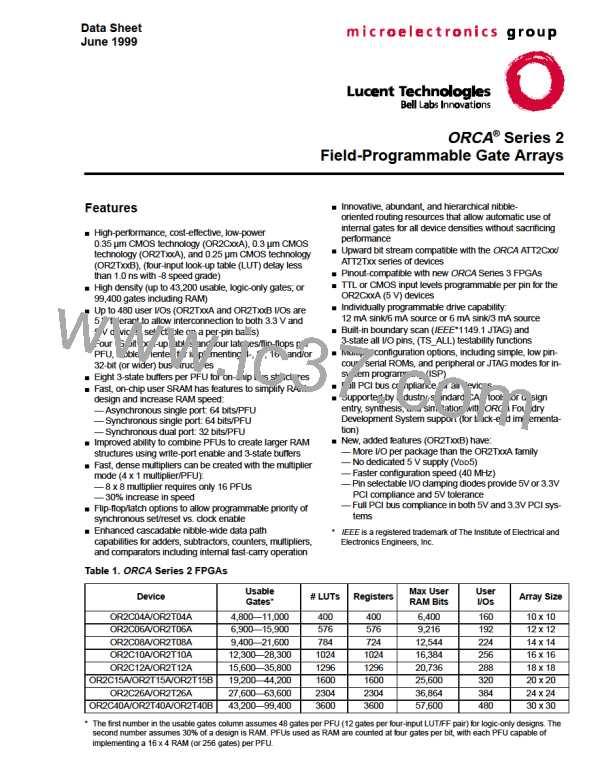Data Sheet
June 1999
ORCA Series 2 FPGAs
as an active-high ready signal, an active-low PROM
FPGA States of Operation (continued)
enable, or a reset to other portions of the system.
When used in SYNC mode, these ANDed DONE pins
can be used to synchronize the other two start-up
events, since they can all be synchronized to the same
external signal. This signal will not rise until all FPGAs
release their DONE pins, allowing the signal to be
pulled high.
Start-Up
After configuration, the FPGA enters the start-up
phase. This phase is the transition between the config-
uration and operational states and begins when the
number of CCLKs received after INIT goes high is equal
to the value of the length count field in the configuration
frame and when the end of configuration frame has
been written. The system design issue in the start-up
phase is to ensure the user I/Os become active without
inadvertently activating devices in the system or caus-
ing bus contention. A second system design concern is
the timing of the release of global set/reset of the PLC
latches/FFs.
The default for ORCA is the CCLK_SYNC synchro-
nized start-up mode where DONE is released on the
first CCLK rising edge, C1 (see Figure 38). Since this is
a synchronized start-up mode, the open-drain DONE
signal can be held low externally to stop the occurrence
of the other two start-up events. Once the DONE pin
has been released and pulled up to a high level, the
other two start-up events can be programmed individu-
ally to either happen immediately or after up to four ris-
ing edges of CCLK (Di, Di + 1, Di + 2, Di + 3, Di + 4).
The default is for both events to happen immediately
after DONE is released and pulled high.
There are configuration options that control the relative
timing of three events: DONE going high, release of the
set/reset of internal FFs, and user I/Os becoming
active. Figure 38 shows the start-up timing for both the
ORCA and ATT3000 Series FPGAs. The system
designer determines the relative timing of the I/Os
becoming active, DONE going high, and the release of
the set/reset of internal FFs. In the ORCA Series
FPGA, the three events can occur in any arbitrary
sequence. This means that they can occur before or
after each other, or they can occur simultaneously.
A commonly used design technique is to release
DONE one or more clock cycles before allowing the I/O
to become active. This allows other configuration
devices, such as PROMs, to be disconnected using the
DONE signal so that there is no bus contention when
the I/Os become active. In addition to controlling the
FPGA during start-up, other start-up techniques that
avoid contention include using isolation devices
between the FPGA and other circuits in the system,
reassigning I/O locations and maintaining I/Os as
3-stated outputs until contentions are resolved.
There are four main start-up modes: CCLK_NOSYNC,
CCLK_SYNC, UCLK_NOSYNC, and UCLK_SYNC.
The only difference between the modes starting with
CCLK and those starting with UCLK is that for the
UCLK modes, a user clock must be supplied to the
start-up logic. The timing of start-up events is then
based upon this user clock, rather than CCLK. The dif-
ference between the SYNC and NOSYNC modes is
that, for SYNC mode, the timing of two of the start-up
events (release of the set/reset of internal FFs and the
I/Os becoming active) is triggered by the rise of the
external DONE pin followed by a variable number of ris-
ing clock edges (either CCLK or UCLK). For the
NOSYNC mode, the timing of these two events is
based only on either CCLK or UCLK.
Each of these start-up options can be selected during
bit stream generation in ORCA Foundry, using
Advanced Options. For more information, please see
the ORCA Foundry documentation.
Reconfiguration
To reconfigure the FPGA when the device is operating
in the system, a low pulse is input into PRGM. The con-
figuration data in the FPGA is cleared, and the I/Os not
used for configuration are 3-stated. The FPGA then
samples the mode select inputs and begins reconfigu-
ration. When reconfiguration is complete, DONE is
released, allowing it to be pulled high.
DONE is an open-drain bidirectional pin that may
include an optional (enabled by default) pull-up resistor
to accommodate wired ANDing. The open-drain DONE
signals from multiple FPGAs can be tied together
(ANDed) with a pull-up (internal or external) and used
42
Lucent Technologies Inc.

 ETC [ ETC ]
ETC [ ETC ]